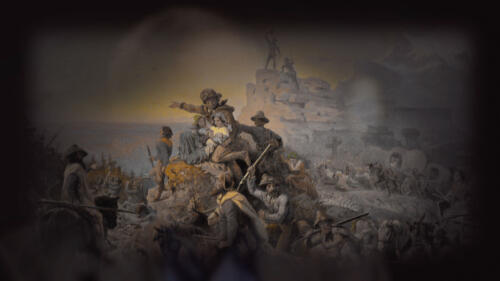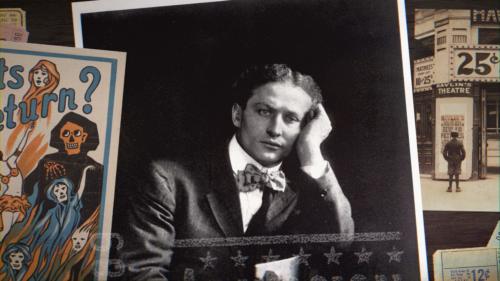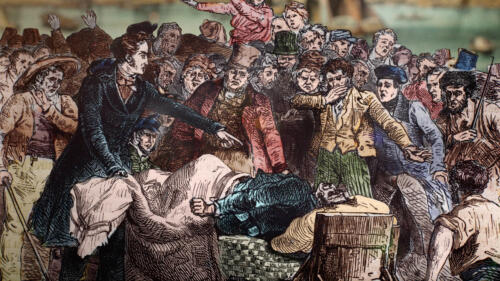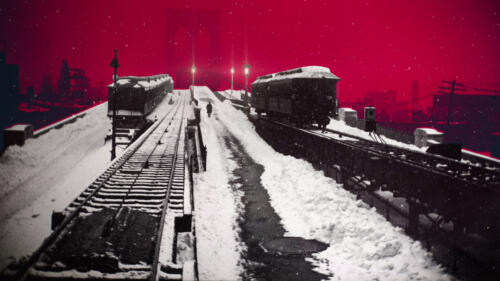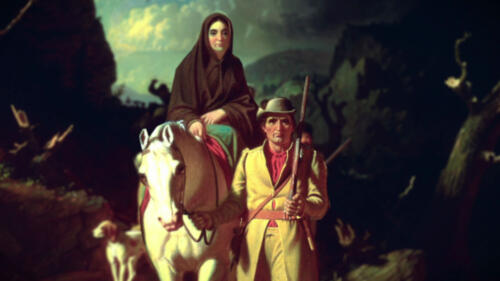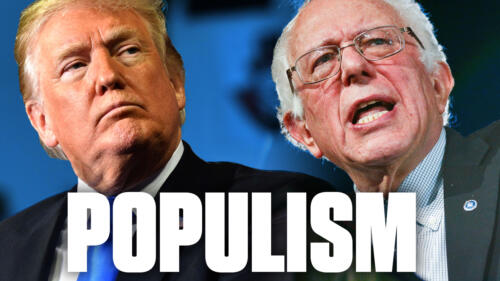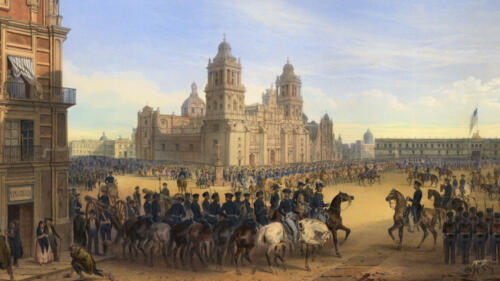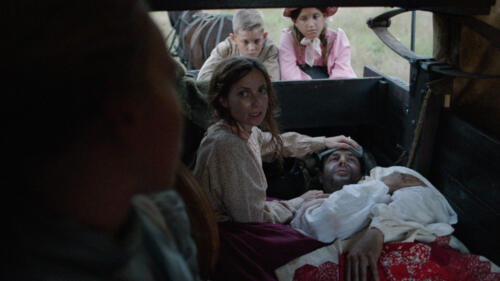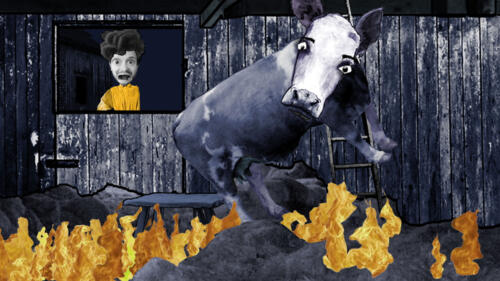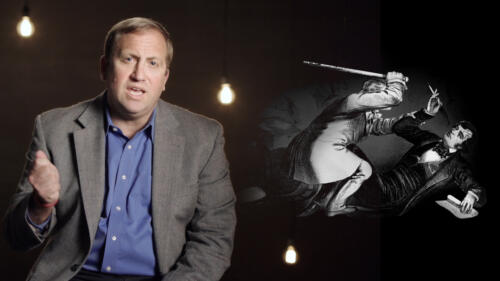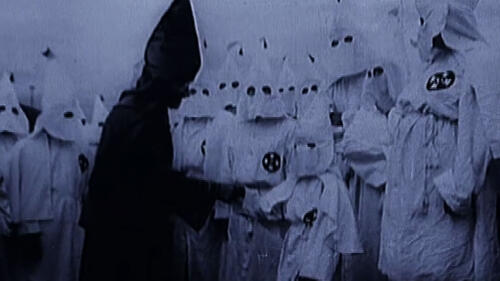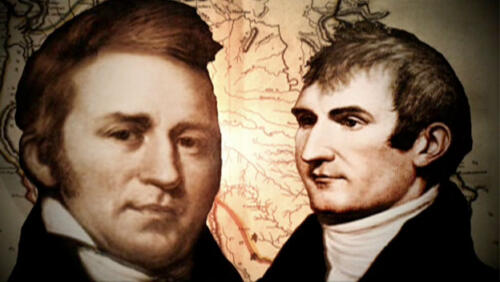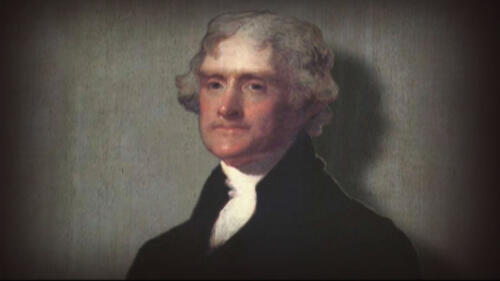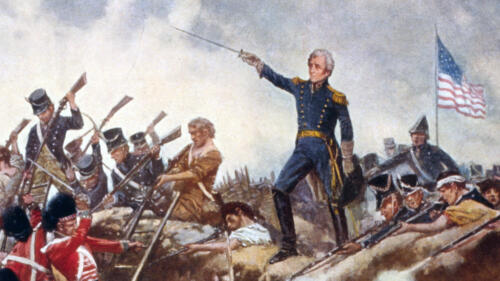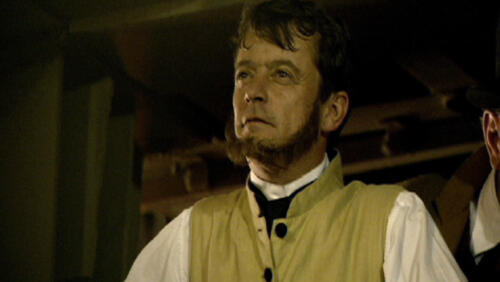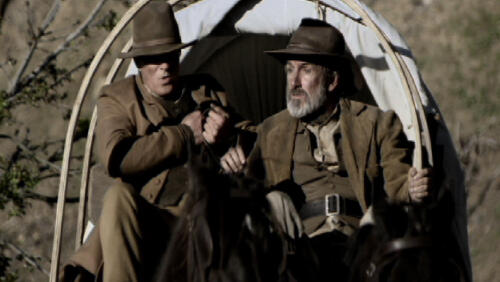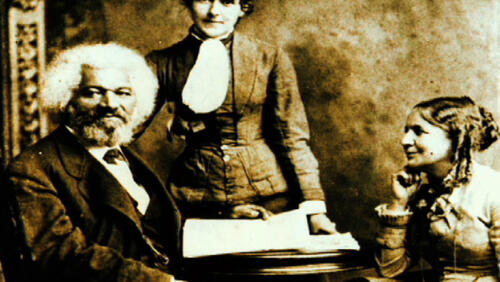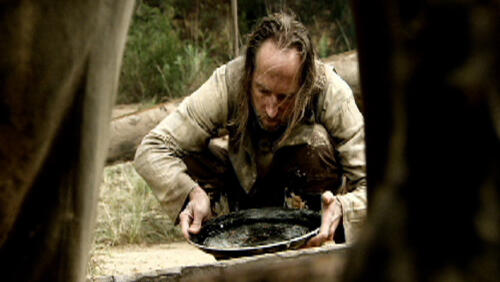19th Century
Though the 19th century saw the rise of populism, the labor movement and Jacksonian democracy, it also ushered in the Gilded Age, when men like Cornelius Vanderbilt and J. P. Morgan wielded vast control over politics and business.
Featured Overview
Historian Matthew Pinsker gives a crash course on the concept of "manifest destiny" and the seeds of westward American expansion.
1:55m watch

MPI/Getty Images
Featured Overview
Historian Matthew Pinsker gives a crash course on the concept of "manifest destiny" and the seeds of westward American expansion.
1:55m watch
Start Here

As American industrialists and financiers accumulated incredible wealth during the Gilded Age, they strove to outdo one another with their lavish spending and possessions.

Facing economic threats and violence, early Chinese immigrants banded together and created communities to survive—and thrive.

The swift, often comfortable ride on the Transcontinental Railroad opened up the American West to new settlement.

The Klondike Gold Rush was a mass influx of prospecting migrants to the Canadian Yukon Territory and Alaska after gold was discovered in those regions in 1896.
Labor Movement
Labor Movement
Analyze the impact of the labor movement in America throughout the 19th and 20th centuries.
2:11 watch

3 19th-Century Industrialists
Explore All Related Topics

Before civil service reforms—introduced after President Garfield's assassination—federal employees could be fired for not making campaign donations.

The 1803 land deal may have been one of history’s greatest bargains, but doubling America’s territory drew sharp criticism—over cost, governability and more.

The first modern U.S. presidential poll was a 1936 Gallup survey. But informal straw polls started much earlier.

Electric vehicles were some of the earliest automobiles ever invented—and, unlike early gas-powered cars, they didn't require a crank to start the engine.

Chief John Ross devoted much of his life to fighting against the forced removal of his people from their ancestral lands.

During the Gilded Age era of opulence in America, certain objects signaled social status.

Facing economic threats and violence, early Chinese immigrants banded together and created communities to survive—and thrive.

As clothing became cheaper and faster to make amid the Industrial Revolution, new, sometimes outrageous fashion designs became chic.

The conflict was their last, best chance for outside military help to protect their homelands from westward expansion.

The Anti-Masonic Party existed for only a decade, but promoted anti-establishment sentiment in its opposition to the dominance of Freemasonry in American politics.

When two young sisters claimed to communicate with ghosts in the mid-1800s, they soon became celebrity mediums and unwittingly spurred a trend.

Thousands of rail workers in states across the country protested poor pay and working conditions in a massive—and violent—uprising.

Russia began encroaching into Alaskan territory in the mid 18th century, eventually establishing settlements as far south as California.

Some of the modern world's most groundbreaking technologies emerged during this 30-year period.

Thomas Nast gleefully mocked the Tammany Hall boss in multiple cartoons, prompting newspapers and authorities to investigate.

Strikes have been a powerful, sometimes perilous tactic for workers as they've fought for better wages and working conditions.

The act is named after Anthony Comstock, a devout Protestant-turned postal inspector who sought to bar the mailing of 'obscene, lewd or lascivious' materials.

Some later accounts of the battle, including Teddy Roosevelt's, downplayed the Black troopers' crucial role in the US victory.

Young ‘Teedie’ suffered from severe asthma and idolized his father, who helped him develop resilience, drive and intellectual rigor.

As the Donner Party fought to survive in the snowy Sierra Nevada mountains, four brave rescue missions ensured some traumatized members made it out alive.

As American industrialists and financiers accumulated incredible wealth during the Gilded Age, they strove to outdo one another with their lavish spending and possessions.

The official declarations of war occurred during five separate military conflicts, starting in 1812 and, most recently, in 1942.

Robber barons amassed vast fortunes during the age that began at the start of the Civil War—and ended with a crash.

In 1871, the Wisconsin town of Peshtigo burned to the ground, killing up to 2,500 people. But it was overshadowed by another fire.

As Europeans sought to control newly settled American land, wars raged between Native Americans and the frontiersmen who encroached on their territory, resources and trade.

Chinese immigrant workers and Indigenous tribes paid a particularly high price.

Spiritualism’s popularity waxed and waned throughout the 19th century and the first decades of the 20th century, and surged on the heels of major wars and pandemics.

As their numbers grew, women operators became a powerful force—for workers' rights and even serving overseas in WWI.

In the 1880s, mobs in Tacoma and Seattle forcibly expelled Chinese residents. In Tacoma, town officials organized the action months in advance.
Harry Houdini is still known today as history's most famous magician, but there was a time when his act needed to be rescued from the dead.
1:02m watch
A cholera outbreak in 19th century London led to a critical advance in public health.
1:04m watch

The 360-mile canal connecting the Hudson River to the Great Lakes was built in eight years through thick forests and stubborn rock.

For all its prominence and power in the mid-19th century, the Whig party became divided over slavery and couldn't keep it together.

Over its 200-year history, the nation’s legislative seat has withstood multiple episodes of violence.

Jesse James. Billy the Kid. Butch and Sundance. Their iconic status endures, despite their history of violent crime.

From 1778 to 1871, the United States signed some 368 treaties with various Indigenous people across the North American continent.

It's clear the California rangers beheaded someone in 1853. What's isn't clear is whether it was the infamous bandit known as 'Joaquín.'

Did the famed band and train robbers bury any of their loot?

The swift, often comfortable ride on the Transcontinental Railroad opened up the American West to new settlement.

Following the Bear Flag Revolt of 1846, California existed as an independent nation—for 25 days.

After fighting in the Civil War and later military engagements, the famous all-black regiments protected the National Parks.

Even though a widely-accepted account says the outlaw was shot by Sheriff Pat Garrett in New Mexico, murky details have led to other theories.

Modern transportation helped make it the first global outbreak.

Rather than expressing love and affection, these cards were designed to offend.

Vast corporate wealth and a fee-based governance structure fueled widespread corruption during America's Gilded Age.

In 1804, Lewis and Clark set off on a journey filled with harrowing confrontations, harsh weather and fateful decisions as they scouted a route across the American West.

The explorers not only produced maps from their 1804-1806 expedition to the American West, they also recorded some 122 animals new to science.
Before salted roads and giant snowplows, one devastating storm brought New York City to a halt. But it may have changed things for the better.
1:02m watch

Santa kidnapping children and murderous mice were par for the course in the Victorian-era Christmas card tradition.

Since 1938, the U.S. federal government has established that workers are entitled to a base hourly wage. Which workers receive that minimum—and how much—has remained a political issue.

A surplus of U.S. corn crops led to a boom in whiskey sales—and consumption—following the Revolutionary War.

Plagued by bad press and fraught with racial and ethnic tensions, the huge steel strike was doomed to fail.

Over 136,000 GM workers participated in the strike in Flint, Michigan that became known as 'the strike heard round the world.'

The country, from its commerce to the environment to even its concept of time, was profoundly altered after the completion of the railroad's 1,776 miles of track.
David McCullough discusses the challenges faced by America's earliest pioneers as they braved harsh conditions to settle westward.
1:02m watch

The magnate with humble roots claimed to be pro-union, but his actions didn’t match his rhetoric.

When the New Madrid earthquakes rattled the Midwest in 1811 and 1812, William Clark, of the Lewis and Clark Expedition, convinced the government to step in.

In 1929, Section 1325 criminalized undocumented immigration for the first time. Its aim was to decrease Mexican immigration.

Over a century ago, a Hindu monk named Swami Vivekananda spoke about yoga to a crowd in Chicago. In the decades since, it has gone from unknown to mainstream.

Census workers were expected to count ‘insane’ and ‘idiotic’ Americans for half a century.

For over a century, the famously deformed 27-year-old’s final resting place was a mystery. One of his biographers believes she’s finally found his burial plot.

Immigrants in 2017 were more likely to speak English and be skilled workers than those in 1907, a new study finds.
Faced with a crisis of orphans on New York City streets, Charles Brace devised a solution – send these children out for adoption in towns across the Midwest. By the end of the Orphan Train program, over 200,000 children had been placed with new families.
4:12m watch

The period of Queen Victoria's reign, from 1837 until her death in 1901 was marked by sweeping progress and ingenuity.

Lawyer William Walker took over Nicaragua and part of Mexico with his own private army.

The pioneers hoped to shave 300 miles off their journey. But the route they took to California had never been tested.

Criminals operated with impunity along the northern border.

The death of King Kamehameha II and Queen Kamamalu was a harbinger of disaster.

During the 1920s, hatred was a family affair.
Populism is defined as a member of a political party claiming to represent the common people. But to understand it’s origins we have to go back to when the term was coined in the 19th century.
6:56m watch

Before his book could be published, William Morgan was dragged away by a group of Masons, never to be seen again.

America didn’t always extend citizenship to those born within its borders.

What if your first photo was taken after you died?

Thousands of Mexican Americans joined the Confederacy—but even more joined the Union.

FDR nominated the Alabama Senator as his first U.S. Supreme Court nominee.

Napoleon was eager to sell—but the purchase would end up expanding slavery in the U.S.

D.W. Griffith’s controversial epic 1915 film about the Civil War and Reconstruction depicted the Ku Klux Klan as valiant saviors of a post-war South ravaged by Northern carpetbaggers and freed Black people.

Two separate police forces— state and city—came head to head in a bloody brawl.

The issue was so hot, it inspired everything from eggings to duels to mob attacks.

The first Gilded Age saw massive wealth inequalities, hyperpartisanship, virulent anti-immigrant sentiment and growing concern about money in politics. Sound familiar?

Some are firsts, others have printing errors and others are simply rare and old—all factors that make these the most sought-after U.S. stamps.

Canada was granted the right to self-government in 1867, but did not gain full legal autonomy until 1931.

Between the 17th and 19th centuries, wife-selling was a weird custom with a practical purpose.

During the Gilded Age, marrying British aristocrats was seen as a way for American heiresses to raise their social status.

The Hermitage was the plantation home of U.S. President Andrew Jackson. Located east of Nashville, Tennessee, the mansion sits on an estate of over 1,100 acres.

The Red Cross, a global humanitarian network which aids victims of disasters and armed conflict, was co-founded in 1863 by Swiss businessman Henry Dunant.

What does the United States want to be to the world?

The 19th-century American West has long been described as a land of opportunity. But for many, it was little more than another place of bondage.

Famed hunter-adventurer Steven Rinella shares seven ways to safely navigate the backcountry.

The 26th president found that simplifying the language was anything but simple.

Spies and scouts, mothers and homestead keepers, women quietly made their mark on America's changing western frontier.

Land symbolized opportunity to generations of Americans, starting with colonists.

The Battle of the Little Bighorn—also known as Custer’s Last Stand—was the most ferocious battle of the Sioux Wars. Colonel George Custer and his men never stood a fighting chance.

The Gilded Age was an American era in the late 19th century which saw unprecedented advancements in industry and technology and the rise of powerful tycoons.

The amazing true story of Bass Reeves, the formerly enslaved man who protected the Wild West.

Native Californians were treated abominably in the area where gold was first discovered.

How the death of a domestic worker’s baby became a symbol in the fight for equal rights for women.

See a colorized version of an early 1900s photo of the president's grandparents.

The Klondike Gold Rush was a mass influx of prospecting migrants to the Canadian Yukon Territory and Alaska after gold was discovered in those regions in 1896.

The Santa Fe Trail, a 900-mile route connecting Franklin, Missouri, to Santa Fe, New Mexico, played a crucial role in America's westward expansion in the 1800s.

Wealthy men turned the famous Paris Opera Ballet into a brothel.

Buffalo Soldiers were the Black U.S. servicemen who fought on the Western frontier after the Civil War and were named by the Native Americans they encountered.

The Oregon Trail, a 2,000-mile route from Independence, Missouri, to Oregon City, Oregon, was used by hundreds of thousands of pioneers in the mid-1800s to emigrate west.

Up to 16,000 Native Americans were murdered in cold blood after California became a state.

Transcendentalism, a 19th-century school of American theological and philosophical thought, embraced nature and the concept of a personal knowledge of God.

Critics tried to dissuade the public from investing money with the female stockbrokers.

Buffalo Bill and Sitting Bull performed together in Wild West shows, and forged what would become a very strange friendship.

The state was once known as 'the world’s sanatorium.'

The Star-Spangled Banner, written by lawyer Francis Scott Key in 1814, emerged as a popular patriotic song before becoming the U.S. national anthem in 1931.
Analyze the impact of the labor movement in America throughout the 19th and 20th centuries.
2:11m watch

Why were parents giving their children heroin in the 1880s?

A desire to fish created an epic 1889 deluge.

Singing schools are obsolete now, but they provided a rare chance to loosen up, socialize and learn something about music

The frontiersman worked hard to build his rustic reputation.

Annoyed at a sit-in by workers, Hershey’s orchestrated a riot.

It's a pithy term that sparked outrage among rich and poor New Yorkers during the 19th century.
Alexander Hamilton and Aaron Burr met on the dueling ground one fateful day, but their story started much earlier.
3:18m watch
America was ready to expand westward, even if it meant going to war. Learn how and why the Mexican-American War happened.
2:11m watch
Over 400,000 people travel West to start a new life and claim new land along the Oregon Trail, including Lucinda Brown. One-hundred seventy years later, one of her descendants sees a kettle from her journey for the first time.
2:41m watch
Find out what a cow has to do with the Chicago fire of 1871 in this animated tale of disaster and destruction in the windy city.
1:59m watch

How—and why—did a groundbreaking physician pass as the opposite sex for more than 50 years?

Forced from their homeland because of famine and political upheaval, the Irish endured vehement discrimination before making their way into the American mainstream.
Historian Matthew Pinsker gives a crash course on the concept of "manifest destiny" and the seeds of westward American expansion.
1:55m watch

Before his death in 1919, steel magnate and philanthropist Andrew Carnegie helped fund the creation of some 2,800 libraries across the world

Michigan and Ohio are now famous for their college football rivalry, but in 1835, the two states nearly went to war over a small strip of land containing the modern day city of Toledo.
Get a crash course on the causes and consequences of the Kansas-Nebraska Act of 1854 with historian Matthew Pinsker.
1:48m watch

In November 1871, journalist Henry Morton Stanley located the missing missionary David Livingstone in the depths of Africa. The famous meeting launched Stanley’s tumultuous career as an explorer.

The renowned sharpshooter competed at Wimbledon and successfully sued William Randolph Hearst for libel.
Learn key facts behind Bleeding Kansas, a series of violent confrontations between pro- and anti-slavery forces during the settling of Kansas, from historian Matthew Pinsker.
1:59m watch

In 1889, people poured into central Oklahoma to stake their claims to nearly 2 million acres opened for settlement by the U.S. government. Those who entered the region before the land run’s designated starting time, at noon on April 22, 1889, were dubbed “sooners.” The area to which the settlers flocked was known as the […]

Legend has it that a meatpacker from Troy, N.Y. may have been the inspiration. But the term may have predated him.

In late August 1921, union miners and coal company supporters clashed near Blair Mountain, West Virginia, in what has been called the largest armed uprising since the Civil War.

In the late 1890s, some 100,000 would-be prospectors journeyed to the remote Yukon region of Canada as part of one of the largest gold rushes in history.

Explore 10 surprising facts about the man often called the “King of the Wild Frontier.”

Explore eight ways that the Erie Canal, which married the waters of the Atlantic Ocean and the Great Lakes, altered the course of American history.

Explore 10 interesting facts about the short-lived mail service that helped transform the American West.

Take a look back at one of the controversial chapters in America’s 19th-century labor movement.

Find out more about the lives of six adventurers who made their mark on the American frontier.

Explore 10 fascinating facts about what has often been called America’s “forgotten war.”

Explore 10 key facts about one of the most gruesome episodes from the era of westward expansion.

Read about the enduring mystery surrounding the deaths of the notorious outlaw, Butch Cassidy, and his partner in crime, the “Sundance Kid.”

In the latter half of the 19th century, Schuylkill County, Pennsylvania, was an area rife with violence. Between 1861 and 1875, a series of violent assaults, arsons and murders was blamed on a secret society of Irish immigrants known as the Molly Maguires. The group had originally emerged in north-central Ireland in the 1840s as […]

Get the facts on Upton Sinclair’s muckraking masterpiece.

Check out nine surprising facts about the route that once served as the gateway to the American West.

Explore seven surprising facts about one of the most storied branches of the armed forces.

Explore 10 surprising facts about one of America’s first and greatest expeditions of discovery.

The name references the year when thousands of prospectors flocked to California to strike gold.

The Black infantry regiments fought in the American-Indian Wars, captured cattle thieves and even served as park rangers.

The legendary frontiersman's background holds some surprises, including his real opinion on coonskin caps and his poor track record in real estate.

A 14-year-old girl has proven that historical scholarship is not solely the realm of tweedy academics. Armed with her curiosity and an Internet connection, Rebecca Fried has debunked a history professor’s claim that “No Irish Need Apply” signs were not historical realities, but “a myth of victimization.

The ghost ship found floating off the coast of the Azores in 1872 became an enduring maritime mystery.

On July 21, 1865, frontier legend Wild Bill Hickok gunned down gambler Davis Tutt in what is often called the first “Wild West” showdown.

Find out more about this Old West icon, from how he met his friend Doc Holliday to what happened to him after the Tombstone gunfight.

The U.S.-Canada border wasn’t always so peaceful. Look back at seven times when the United States clashed violently with its northern neighbor.

A British rock legend’s unlikely fascination drove him to amass the world’s largest private collection of Alamo relics, which he recently donated to the Texas landmark.

According to unsubstantiated legend, the “yellow rose of Texas” quietly played a crucial role in the Battle of San Jacinto, helping Texas gain its independence from Mexico. But who was that “yellow rose,” memorialized in a 19th-century ballad, and what’s actually known about her? In the fall of 1835, a free African American woman from […]

Learn seven surprising facts about the legendary political and military leader who fought for Texan independence.

Check out six surprising facts about the flamboyant Mexican political and military ruler.

From the origins of his famous name to the mystery surrounding his death, the legendary American outlaw.

From a wild boy kept as a pet in King George’s court to an Indian who was supposedly raised by wolves, learn the puzzling and often tragic stories of six famous feral children

The Dreyfus Affair was a political scandal that rocked France between 1894 and 1906 and revealed growing antisemitism across Europe.

Learn the truth behind six common myths about the last major engagement of the War of 1812.

Between his days as a teenage Confederate guerrilla and his murder at age 34, James became one of America’s most notorious outlaws.

In 1869, trickster George Hull masterminded one of the 19th century’s most sensational hoaxes: the discovery of a 10-foot-tall giant.

Explore more about one of the 19th century’s most infamous financial scandals.

Ten surprising facts about the national anthem and the man who wrote its lyrics.

As the War of 1812 neared its conclusion, British forces torched the White House, the Capitol and nearly every other public building in Washington.

A look back at the day when 50,000 “boomers” and “sooners” made a mad dash to stake their claims in the Oklahoma Land Rush.

Even before Oregon Country—the disputed area claimed in the early 1800s by both Great Britain and the United States—was officially claimed by Congress as a United States territory in 1846, pioneers had been traveling west to explore its bounty. Meriwether Lewis and William Clark had arrived at the Pacific Ocean in 1805, but the route […]

National anthems are often only dusted off for patriotic holidays and sporting events, but these stately hymns and marches can also serve as a window into their country’s cultural and political history.

It definitely can't hold that much fluid, so the name likely has a different origin.

Get the facts on six of history’s most preposterous conflicts.

Check our seven things you may not know about the International Red Cross.

Get the facts on the legendary Shawnee war chief, who took part in the worst defeat ever inflicted by Native Americans on U.S. forces.

Explore 10 true stories of the Wild West, some of them stranger than fiction.

“We have met the enemy and they are ours,” proclaimed Oliver Perry after defeating a British fleet on Lake Erie.

From ancient Roman sausage to Nathan's Coney Island hot dog, the history of tubular meat may stretch back millennia.

Get the facts about John Jacob Astor, America’s first multi-millionaire.

Get the facts on seven people who defied the odds to establish themselves among the richest and most powerful figures of their time.

Explore some surprising facts about the iconic span.

A look behind the scenes of the historic real-estate deal.

Get the grisly details.

On January 24, 1848, gold was discovered at Sutter’s Mill in Northern California. Get the facts on the rush for gold that followed.

From group marriage to restrictions on hot baths, explore the surprising practices of five utopian communities in 19th-century America.

Get ready for the premiere of The Men Who Built America with five facts about the series’ principal subjects.

Take a look back at a landmark victory for American workers: the 1912 Bread and Roses Strike.

In August 1812, USS Constitution defeated HMS Guerriere and earned the nickname “Old Ironsides.”

The United States’ invasion of Canada 200 years ago went awry from the start.

The US invaded Canada. New England nearly seceded. And after being torched, Washington, D.C. was almost abandoned.
The famed Industrialist breaks the back of organized workers.
3:39m watch
Following the Civil War, the Ku Klux Klan emerges to suppress and victimize newly freed slaves.
2:52m watch
In 1804, Jefferson sends a team to explore lands acquired in the Louisiana Purchase. The Corps of Discovery will travel nearly 8,000 miles over three years, reaching the Pacific Ocean and clearing the path for westward expansion.
1:46m watch
Thomas Jefferson pulls off the land deal of the millennium when he buys 800,000 square miles from the French, stretching from the Mississippi River to the Rocky Mountains
1:24m watch
No-nonsense commander Andrew Jackson cleverly defended New Orleans against the threat of an overwhelming British force during the War of 1812.
3:23m watch
Meet Andrew Carnegie and find out how the wealthiest man of his day ended up giving away his vast fortune.
2:11m watch
Western migration through uncharted regions strands a wagon train in the Sierra Mountains leaving little choice for survival.
4:24m watch
The election of Abraham Lincoln was a tipping point on the path to Civil War. In the wake of Southern secession, would the new president defend the U.S. forts in rebel territory?
2:25m watch
Find out how the transcontinental railroad transformed America into one nation.
3:27m watch
Find out how Frederick Douglass escaped from slavery to become one of the most respected and effective abolitionist leaders.
2:25m watch
Discover how the Gold Rush led to the creation of California.
2:37m watch

Jacksonian Democracy refers to the ascendancy of President Andrew Jackson (in office 1829 –1837)and the Democratic party after the election of 1828. More loosely, it alludes to the entire range of democratic reforms that proceeded during Jacksons’ tenure—from expanding suffrage to restructuring federal institutions, but also slavery, the subjugation of Native Americans, and the celebration of white supremacy.

After a century-long ban, France has legalized absinthe, a potion with a rich history that artists once prized for its supposed hallucinogenic effects.

The Crédit Mobilier scandal of 1872-1873 damaged the careers of several Gilded Age politicians. Major stockholders in the Union Pacific Railroad formed a company, the Crédit Mobilier of America, and gave it contracts to build the railroad. They sold or gave shares in this construction to influential congressmen.

Cowboys originated with the Spanish settlers in modern Mexico, before becoming synonymous with the American West during the cattle drives of the 1800s.

George Waring was a 19th century engineer who devised an innovative sewage system for Memphis, Tennessee, before initiating sanitation reforms in New York City.

Cornelius Vanderbilt (1794-1877) was a shipping and railroad tycoon, and a self-made multi-millionaire who became one of the wealthiest Americans of the 19th century.
![Cumberland Gap', 1872. View of the pass through the Cumberland Mountains on the border of Kentucky and Virginia, USA. From "Picturesque America; or, The Land We Live In, A Delineation by Pen and Pencil of the Mountains, Rivers, Lakes...with Illustrations on Steel and Wood by Eminent American Artists" Vol. I, edited by William Cullen Bryant. [D. Appleton and Company, New York, 1872]. Artist Harry Fenn.](https://res.cloudinary.com/aenetworks/image/upload/c_fill,ar_1.7777777777777777,w_640,h_360,g_auto/dpr_auto/f_auto/q_auto:eco/v1/gettyimages-1187600351-2?_a=BAVAZGDX0)
The Wilderness Road, blazed by frontiersman Daniel Boone through the Cumberland Gap, opened a western pathway that led to the first settlements in Kentucky.

The Gold Rush in California started in 1848 after gold was found at Sutter’s Mill. Within a year, hundreds of thousands of 49ers seeking fortune poured into the state.

Conestoga wagons, known for their curved floors and canvas covers, originated in Pennsylvania's Lancaster County and were commonly used by the early 1800s.

Manifest Destiny, a phrase coined in 1845, expressed the philosophy that drove 19th-century U.S. territorial expansion. It contended that the United States was destined by God to expand its dominion and spread democracy and capitalism across the entire North American continent.

Susannah Dickinson, wife of Captain Almaron Dickinson, provided an eyewitness account of the 1836 Battle of the Alamo as one of its few survivors.

Davy Crockett was a woodsman, soldier, politician, and prolific storyteller. Before his death at the Alamo, the “King of the Wild Frontier” was an American folk hero.

The Donner Party was a group of 89 emigrants from Illinois who purportedly turned to cannibalism to survive after getting trapped by snowfall while on a westward journey in 1846. Forty-two members of the party died.

Early History of the Alamo Spanish settlers built the Mission San Antonio de Valero, named for St. Anthony of Padua, on the banks of the San Antonio River around 1718. They also established the nearby military garrison of San Antonio de Béxar, which soo...

Daniel Boone was a hunter, politician, land speculator and frontiersman whose name is synonymous with the Cumberland Gap and the settlement of Kentucky.

The Chicago Fire of 1871, rumored to have started when a cow kicked over a lantern, killed an estimated 300 people and caused some $200 million in damages.

The Tenure of Office Act was a law meant to restrict the U.S. president's power to remove certain officials. Passed in 1867, it was repealed 20 years later.

The Battle of Plattsburgh, held in and on the shores of Lake Champlain in northern New York, was a decisive victory for the Americans late in the War of 1812.

The Haymarket Riot followed a Chicago labor protest rally in May 1886, resulting in at least eight deaths and the conviction of eight radical labor activists.

The Bank War of 1832 was the political struggle that ensued over the fate of the Second Bank of the United States during the presidency of Andrew Jackson.

Westward expansion, the 19th-century movement of settlers into the American West, began with the Louisiana Purchase and was fueled by the Gold Rush, the Oregon Trail and a belief in "manifest destiny."

The Louisiana Purchase of 1803 introduced about 828,000,000 square miles of territory from France into the United States, thereby doubling the size of the young republic. Explore the facts about this important acquisition and its lasting legacy on Thomas Jefferson’s presidency.

Liliuokalani ruled Hawaii as its first queen and final sovereign of the Kalākaua dynasty, until an American-led coup overthrew the monarchy in 1893.

Sam Houston (1793-1863) was a lawyer, congressman and senator from Tennessee. After moving to Texas in 1832, he joined the conflict between U.S. settlers and the Mexican government and became commander of the local army. On April 21, 1836, Houston and his men defeated Mexican General Antonio López de Santa Anna at San Jacinto to secure Texan independence.

The Battle of Palo Alto, waged along the disputed Texas-Mexico border in May 1846, saw U.S. forces led by General Zachary Taylor defeat a larger Mexican army.

The Battle of New Orleans of January 1815 saw Andrew Jackson and a ragtag group of soldiers successfully repelling a superior British force in the War of 1812.

The Monroe Doctrine, established by President James Monroe in 1823, was a U.S. policy of opposing European colonialism in the Western Hemisphere.

The Mexican-American War was a 1846-1848 conflict over vast territories in the American West, which the Treaty of Guadalupe Hidalgo gave to the United States.

The Lewis and Clark Expedition began in 1804 when Thomas Jefferson asked Meriwether Lewis and William Clark to explore the lands of the Louisiana Purchase.

One of the most powerful bankers of his era, J.P. Morgan (1837-1913) financed railroads and helped organize U.S. Steel, General Electric and other major corporations. In 1895, he helped organize the investment bank J.P. Morgan & Company, a predecessor of the modern-day financial giant JPMorgan Chase.

The Treaty of Ghent was signed by British and American representatives at Ghent, Belgium, in December 1814, bringing an end to the War of 1812.

The Bear Flag Revolt lasted from June to July 1846, after a small group of American settlers in California rebelled against the Mexican government and proclaimed California an independent republic. The republic was short-lived because soon after the Bear Flag was raised, the U.S. military began occupying California, which went on to join the Union in 1850. The Bear Flag became the official California state flag in 1911.

Daniel Webster emerged as one of the greatest orators and most influential statesmen in the United States in the early 19th century. As an attorney, he argued several landmark cases before the Supreme Court that expanded the power of the federal government.

Andrew Carnegie was a Scottish-born industrialist who became very wealthy via the steel industry before giving away much of his fortune as a philanthropist.

Wyatt Earp, a famous figure from the American West, is best remembered for his participation in a deadly gunfight at the OK Corral in Tombstone, Arizona.

The Whig Party was formed in 1834 by opponents to Jacksonian Democracy. Guided by their most prominent leader, Henry Clay, they called themselves Whigs—the name of the English antimonarchist party.

The Lincoln-Douglas debates were a series of seven public debates in 1858 between Republican challenger Abraham Lincoln and incumbent Democratic Senator Stephen A. Douglas. The main topic was slavery and the battle over its extension into new U.S. territories.

The labor movement in the United States emerged from the artisans of the colonial era and gained steam with the widespread formation of unions in the 1800s.

The Ku Klux Klan (KKK) is an American white supremacist terrorist hate group founded in 1865. It became a vehicle for white southern resistance to the Republican Party’s Reconstruction-era policies aimed at establishing political and economic equality for Black Americans.

The Knights of Labor, founded in 1869, was a prominent national labor organization that advocated for the eight-hour day, a graduated federal income tax, as well as other worker protections.

The Kansas-Nebraska Act was an 1854 bill that allowed settlers of Kansas and Nebraska to decide whether slavery would be allowed within their state's borders. The conflicts that arose between pro-slavery and anti-slavery settlers in the aftermath of the act’s passage led to the period of violence known as Bleeding Kansas, and contributed to unrest that led to the American Civil War (1861-65).

The War of 1812 between the United States and Great Britain was ignited by British attempts to restrict U.S. trade and America's desire to expand its territory.

Bleeding Kansas describes the period of repeated outbreaks of violent guerrilla warfare between pro-slavery and anti-slavery forces following the creation of the new territory of Kansas in 1854.
